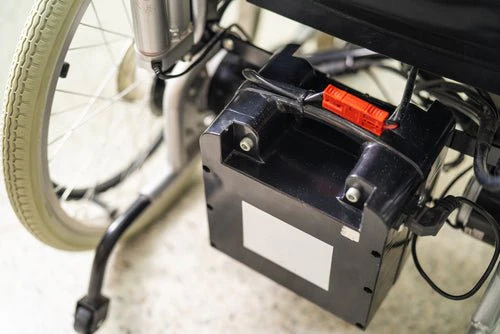
How to revive a dead wheelchair battery: A comprehensive guide
Whether you’re preparing to go out or your wheelchair stops working outdoors, a dead battery can cause a lot of panic.
But this doesn’t have to be the case. At Millercare, we will walk you through ways to extend your battery life and revive a seemingly dead battery.
This is both cost-effective and a quick way to get back out into the world again. If you're ready to purchase a new wheelchair, browse our range of electric wheelchairs today for a wheelchair you can rely on.
Signs of battery deterioration
There are various signs that your wheelchair battery may be deteriorating. Some common signs to look out for include:
- Gradual loss of power: Your wheelchair doesn’t move as swiftly or cover as much distance.
- Dying quickly after charge: Your battery drains quickly and requires frequent charging.
- Sluggish performance: Moves slowly or struggles up inclines.
- Overheating: The battery gets unusually hot during or after charging.
- Swelling or leaking: You notice swelling or bulging in the battery casing, or it starts leaking fluid.
- Odour or strange sounds: Unusual odours or hissing and popping noises indicate internal problems.
- Increased charging time: The battery takes longer to reach a full charge.
- Error codes: Your wheelchair's display panel shows error codes related to the battery.
- Sudden loss of power: Your wheelchair suddenly dies whilst in use.
Preparing for battery revival
Before reviving your dead wheelchair battery, choose a well-ventilated area and have a fire extinguisher nearby as a safety precaution.
It may also be necessary to wear gloves and safety goggles when inspecting the battery in case of chemical spills or leaks. For batteries with leaks or swelling, contact a professional rather than attempting a revival, as it may rupture or explode.
Then, gather the necessary tools and materials, including:
- Lead-acid or lithium-ion battery charger
- Multimeter
- Distilled water (for Lead-acid Batteries)
- Cleaning supplies (baking soda and water)
- Battery hydrometer (for Lead-acid Batteries)
- Battery load tester (Optional)
How to revive a dead wheelchair battery
1. Initial assessment
Damaged batteries, such as those with dents, cracks, or bulging, should be replaced immediately.
If no visual signs of damage are noticed, use a multimeter to check the battery voltage. To do this, set it to the DC voltage setting and connect the red probe to the positive terminal and the black probe to the negative terminal of the battery.
A dead battery may show a voltage reading close to zero.
2. Drain the battery safely
Ensure that your wheelchair is turned off and disconnect any accessories. This will prevent any electrical load on the battery during the process.
Then, let the battery rest for a few hours before continuing. You can leave it to drain overnight for extra precaution.
3. Inspect and clean the battery
Examine the battery for signs of leaks, swelling and wear and tear. If any are detected, don't proceed with the revival and contact a professional.
If everything seems fine, clean the battery with baking soda and water. This will get rid of any corrosion and prevent hindrance to the flow of electricity.
Once this is done, rinse and dry the battery to remove any residual moisture.
4. Check electrolyte levels
To check the electrolyte levels of a lead-acid battery, remove the caps from the battery cells.
Then, check the electrolyte levels in each cell, which should cover the lead plates. If any of the cells are low, add distilled water to bring them back to the proper level.
Put the caps back on afterwards.
5. Recharge the battery
Ensure your charger matches the voltage of the battery. Then, check that it’s unplugged from the power source before connecting.
Allow it to charge until it’s full.
6. Test battery voltage and capacity
Use a multimeter to measure the voltage. If the process is working, the battery should have increased compared to the initial assessment.
For a more thorough reading, use a load tester. This measures the battery's capacity under load, providing more information on its health.
7. Restore battery performance
If this process doesn’t restore the battery, repeat it a few more times as this can revive a dead battery further.
If the battery still shows signs of sulfation, consider trying desulfation methods. Electronic desulfators or Epsom salt solutions can be used for lead-acid batteries.
If the battery remains faulty after trying these methods, contact a professional for assistance.
Maintenance tips for your wheelchair battery
To extend the life of your battery and practice better care for your wheelchair, follow these tips:
- Charge your battery overnight or after each use to keep it at full or near-full capacity
- Recharge the battery whenever you see a low-power warning
- Disconnect the battery when storing it to prevent parasitic drain over time
- Regularly check the battery for signs of corrosion or buildup
- Clean the terminals regularly with baking soda and water
- Apply a battery terminal protector or anti-corrosion spray to prevent future corrosion
- Avoid accidental drops or jolts of the battery
- Ensure the battery is securely fastened to prevent shifting during use
Invest in a wheelchair you can rely on with Millercare
At Millercare, we understand what it takes to support those with mobility issues. That is why our wheelchairs are designed to be long-lasting, supportive, and comfortable for frequent use.
With a range of options to choose from, from manual wheelchairs to sports chairs, we have the perfect solution for every customer. Browse our products today and invest in your future with us.